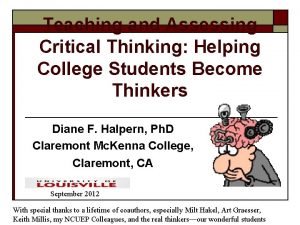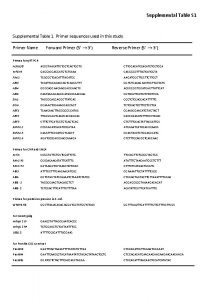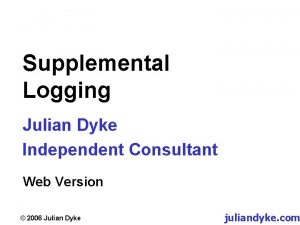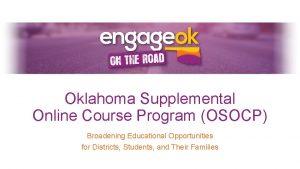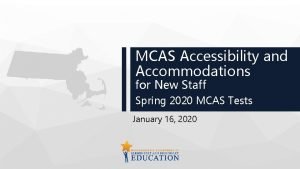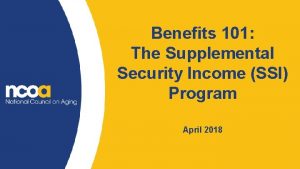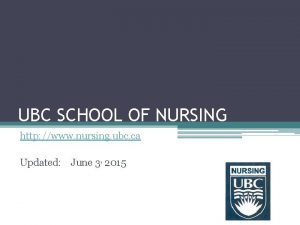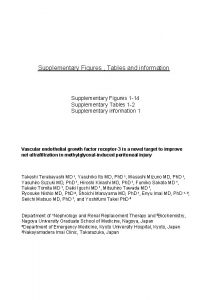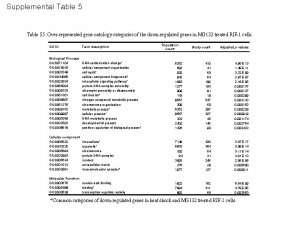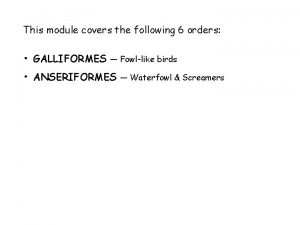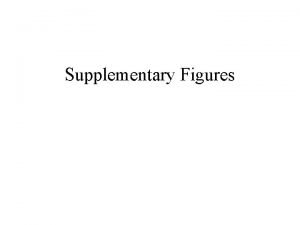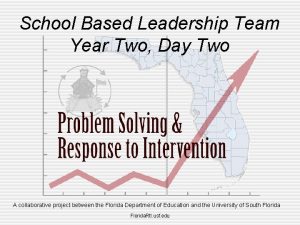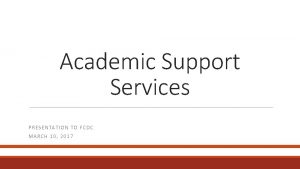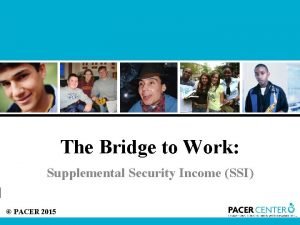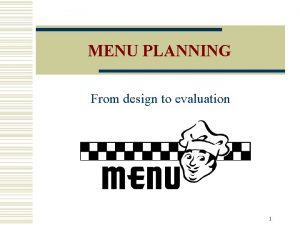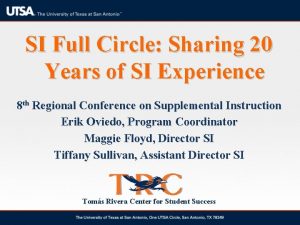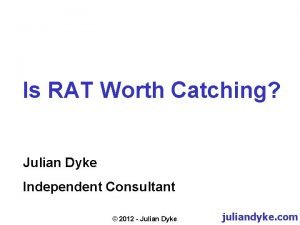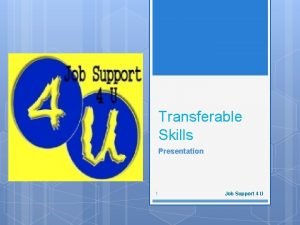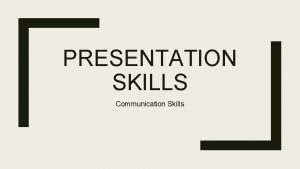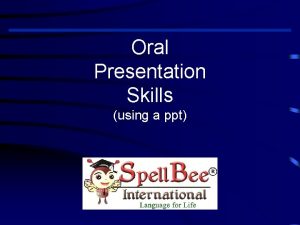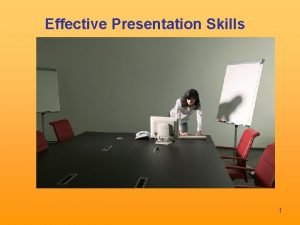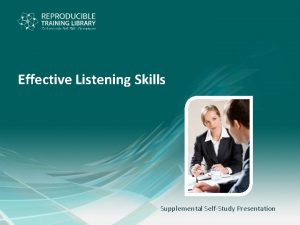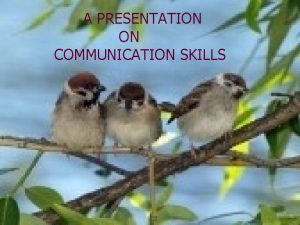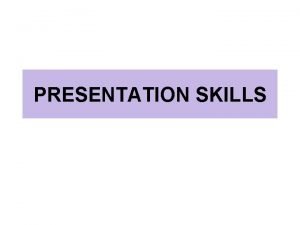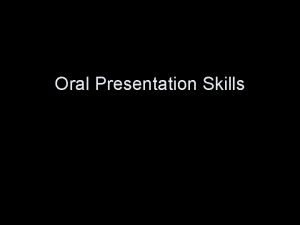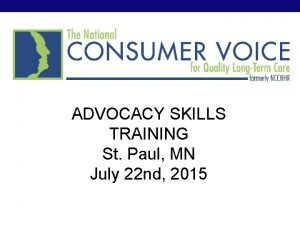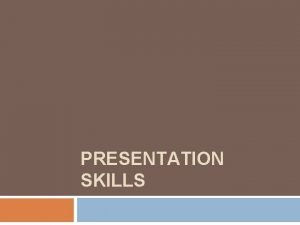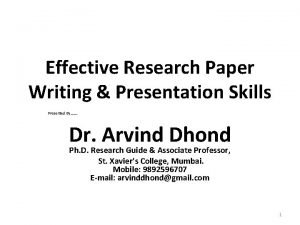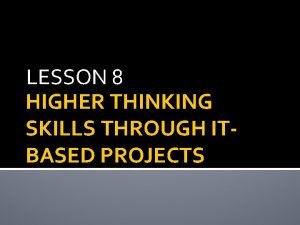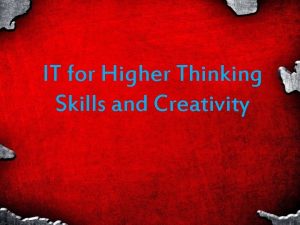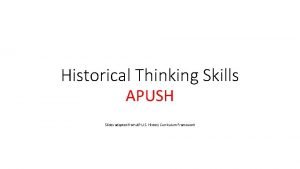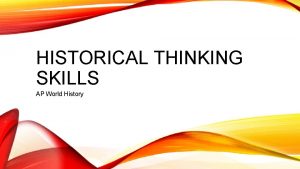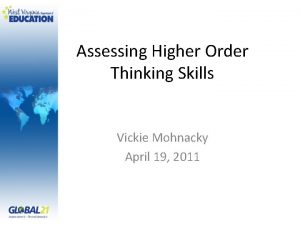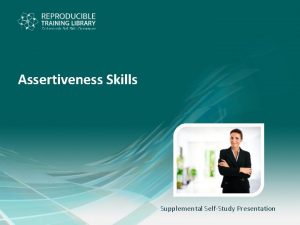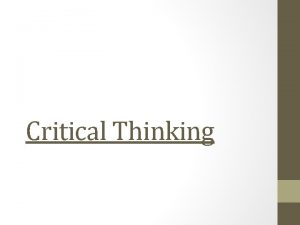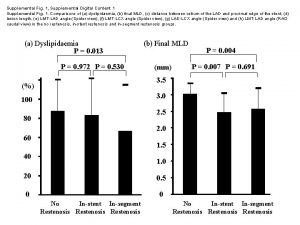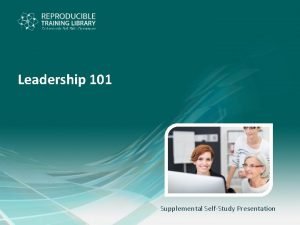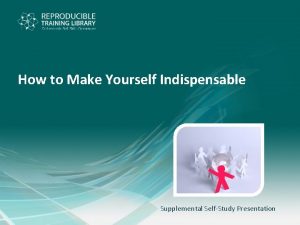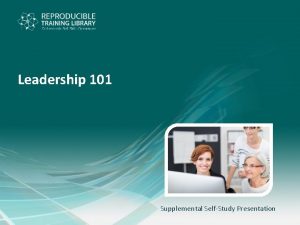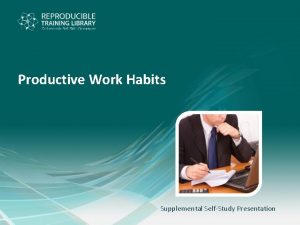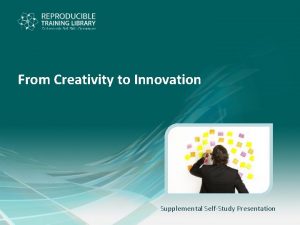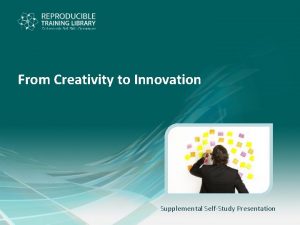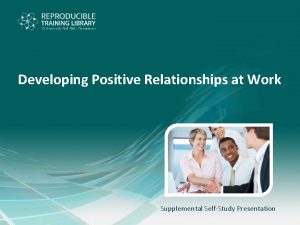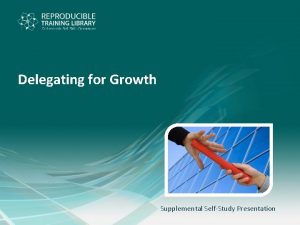Critical Thinking Skills Supplemental SelfStudy Presentation Critical Thinking




















































- Slides: 52

Critical Thinking Skills Supplemental Self-Study Presentation

Critical Thinking Skills Overview

Critical Thinking Skills Introduction In today’s fast-paced workplace, decisions often have to be made quickly, effectively and without doubt. It is increasingly important for employees to be able to think critically on their own. When employees excel at critical thinking, they can assess all possible approaches to a problem and choose the best solution confidently and calmly. Executives repeatedly highlight critical thinking skills as a sought-after trait in new hires and current employees. The AMA Critical Skills Survey asked 2, 115 managers and executives to assess the importance of critical thinking skills. Seventy-two percent agreed that current employees’ success is measured by their critical thinking skills. When asked if their organizations make an effort to assess critical thinking when hiring new employees, seventy-six percent said yes. i This course will enable you to learn the components of critical thinking and avoid blocks to critical thinking. As a result, you’ll be able to think more creatively and independently, make better decisions by problem solving systematically, identify the value of ideas and reach wellreasoned conclusions.

Critical Thinking Skills What Kind of Car Do You Own? Think about the kind of transportation you use. • Why did you choose that particular car or method? • Why doesn’t everyone make the same choice? • How did critical thinking affect your choice (or not)?

Critical Thinking Skills What is Critical Thinking? Critical thinking is reasonable, reflective thinking that is focused on deciding what to believe and what to do. It uses the identification and evaluation of evidence to guide decision making.

Critical Thinking Skills What Critical Thinking Is Not Despite the negative connotations of the word “critical, ” critical thinking is not being argumentative or critical of other people. Critical thinking involves engaging with information, not just receiving it. If you acquire information without evaluating it or evaluate information without investigating it, then you are not using critical thinking.

Critical Thinking Skills Benefits of Critical Thinking Critical thinking enables you to: • Think independently. • Make better decisions. • Deal with change quickly and effectively. • Solve problems systematically. • Think more creatively. • Increase self-reflection (and thus, be more receptive to self-improvement). • Detect inconsistencies and common mistakes in reasoning. • Recognize your own assumptions and biases. • Identify the importance and relevance of various ideas. • Reach well-reasoned conclusions and solutions.

Critical Thinking Skills Top Employee Skill Now and in the Future According to a study by The Conference Board, 400 senior HR professionals were asked to name the most important skill that employees will need in the next five years: Critical thinking ranked #1.

Critical Thinking Skills Module 1: Characteristics of Critical Thinking

Critical Thinking Skills Curiosity The purpose of critical thinking is not to be right, but to gather and assess the right information. One way to do that is to adopt the natural curiosity of a child. Think Like a Child • Take a naïve observer perspective. Imagine you know nothing about the issue and are hearing about it or seeing it for the first time. Remove all your preconceived notions. • Show some humility; don’t let pride or ego get in the way of clear thinking. Don’t stubbornly cling to a position when evidence points to the contrary. • Ask questions that reflect your willingness to grasp and accept new ideas and conclusions. • Project inquisitiveness and excitement rather than skepticism and negativity.

Critical Thinking Skills Awareness is knowing what you know, and knowing what you don’t know. This idea is best illustrated by Joari’s Window, a concept developed in 1955 and named for its creators, Joseph Luft and Harry Ingham. This is particularly critical when examining our assumptions. Often, assumptions will fall in the Blind or Unknown categories—we don’t recognize our own assumptions and biases. This is especially important when examining your assumptions. An effective critical thinker must be able to discover his or her blind spots as well as the unknown in order to make reasonable, reflective decisions. The Johari Window

Critical Thinking Skills Flexibility Someone who is flexible: • Is open to new information • Changes approach or perspective in response to unexpected obstacles or changing conditions • Adapts easily and rapidly to new situations and new information • Considers alternative points of view without being attached to any one perspective • Plays devil’s advocate: Intentionally considers the issue from another perspective • Deals with ambiguity without getting stressed out • Solves problems through compromise and consensus and is willing experiment with another person’s ideas

Critical Thinking Skills Test Your Flexibility What do you see? The outline of a face with glasses or the word “Liar”

Critical Thinking Skills Common Sense Common sense helps you to spot a simple explanation for the situation or problem you have overlook, but it’s not as easy (or as common) as it sounds. Common sense is about: • Verification and accuracy. For example, considering whether numerical figures are accurate. • Paying attention to the obvious. Ask yourself, does it pass the “sniff test”? Think of outlandish urban legends, like stores of people who follow their GPS when it tells them to drive into a building. • Considering the source.

Critical Thinking Skills Test Your Knowledge Test your common sense by taking this quiz. Click on each question to reveal the answer. A. Two men play five games of checkers. Each man wins the same number of games. There A. They were playing different people. are no ties. Explain this. B. B. A farmer has 17 sheep; all but 9 die. How many are left? 9 C. If you have only one match and you walked into a room where there was an oil burner, a C. The match. kerosene lamp, and a wood burning stove, which one would you light first? D. You have two U. S. coins totaling 55 cents. One is not a nickel. What are the coins? D. A 50 cent piece and a nickel. Only one is not a nickel. E. E. Divide 30 by 1/2 and add 10. What is the answer? 70

Critical Thinking Skills Module 2: Critical Thinking Mistakes

Critical Thinking Skills Rationalization is the opposite of logical thinking. It arises from a desire to avoid being wrong. When you think logically, you start with the evidence and reach a conclusion. With rationalization, you begin with the conclusion you want and then gather evidence to support your conclusion. A common result of using rationalization: Excuses! To avoid: • Determine your true motivation for believing something or thinking in a certain way. • Listen carefully to others’ explanations—both to uncover valid reasoning you haven’t thought about and to detect whether they are using invalid reasoning.

Critical Thinking Skills Emotional Thinking Another critical thinking mistake is emotional thinking. This is not the same thing as intuition. Intuition has a place in critical thinking, which we’ll look at later in the program. We’re using the term “emotional thinking” to mean the absence of logic. Emotional thinking usually occurs in several ways. First, emotional thinking can happen when you react to a “feeling” or emotional language rather than the facts. Look at these two sets of words: Public Employee Bureaucrat Medical procedure Life-saving surgery Evacuate Flee Disturbance Riot House Home Which set evokes more emotions? Most people agree that the second set does. To avoid the pitfall of emotional thinking, strive to separate the facts from your feelings.

Critical Thinking Skills Emotional Thinking Part 2 Emotional thinking also occurs in these ways: Wishful thinking • o Wishful thinking is an unrealistic belief in something simply because you wish it were true. Advertisers often take advantage of this when selling “quick-fix” products. Polarization • o Polarization is an emotional attachment to one side of an issue. o This often occurs when someone you trust persuades you that a particular belief is right, and all other beliefs are wrong. To avoid: • Separate facts from feelings. • Focus on developing flexibility • Carefully follow the critical thinking process until it becomes second nature.

Critical Thinking Skills Test Your Knowledge Read the sentence below, identify the emotional or polarizing language, and consider how you would rewrite it to eliminate those words. Then, click on the sentence to reveal the suggested answer. Emotional or polarizing words: disastrous, dismantle, perfectly good, just so, cling The new manager’s leadership is disastrous; she intends to dismantle a perfectly good Rewrite: The new manager’s leadership is uninspiring; she intends to rework a system to make it system just so she can cling to her familiar way of doing things. more familiar to her.

Critical Thinking Skills Biases Bias is a preference, partiality, or favoritism toward a certain point of view, based on any of the following: • Confirmation bias: The tendency to seek information that proves, rather than disproves, our theories • Hindsight bias: The tendency to see past results as different or more probable than initially thought • Recency effect: The tendency to give more credence to the most recent data you receive • Overconfidence: The tendency to overestimate the credibility of your point of view or trust a source just because you’re familiar with it To avoid: • Carefully reflect on your reactions, looking for bias. • Trust, but verify. Don’t allow your relationship with a source to influence your judgment so much that you ignore or disregard documented evidence.

Critical Thinking Skills Tunnel Vision Tunnel vision occurs when we behave in a set way – in certain patterns – without considering or even realizing that there are other options outside of what we see/know. It represents an ingrained way of thinking that is often the result of our upbringing, culture, conditioning, etc. It causes us to: • Put on blinders • Miss the big picture • Believe there is only one right answer to the issue or problem facing us To avoid: • Actively consider other perspectives. • Seek out someone with a different perspective and ask for his or her input.

Critical Thinking Skills Module 3: The Critical Thinking Process

Critical Thinking Skills EEE The critical thinking process can be split into three parts: Examine • Identify the issue or problem. • Collect information. Explore • Uncover assumptions and biases. • Interpret information. • Brainstorm alternative explanations or solutions. Evaluate • Assess explanations or solutions. • Reach a conclusion.

Critical Thinking Skills Examine: Identify the Issue or Problem You can’t evaluate what you can’t identify. • Separate the issue from the evidence. • The issue is the question or situation that requires an answer or conclusion. It is not examples, statistics, evidence, or conclusions. • Make certain you identify the fundamental question or problem and not merely a symptom of it.

Critical Thinking Skills Examine: Collect Information Search for the 5 W’s and H: Who, what, where, when, why, and how using any or all of the following: • Examples • Statistics • Research findings • Expert testimony: Who is the expert? What is the depth and breadth of his or her experience as it relates to this issue? • Observation/personal experience • Intuition (This may not seem like evidence; however, it is based on past experiences, which are often the best indicators of future behavior or performance. However, intuition can be unreliable when it disregards other evidence. So, include it as one element of evidence, but not the only element. ) o Recognize a situation that may mislead other people. Example: When a sensational but extremely rare catastrophic earthquake occurs in a city, people may begin to think of that city as earthquake-prone or unsafe, even though that may not be the case.

Critical Thinking Skills Explore: Interpret Information The second step in the critical thinking process is to explore. Once you collect your information, you must begin to make sense of it. • Separate fact from opinion: Look or ask for the evidence to back up the information. Facts are concrete and can be documented. • Clarify ambiguous words, phrases, examples, or statistics. Ask the source “What do you mean by that? ” if possible, or substitute an alternative meaning for the ambiguous item and see if it changes your interpretation. Example: “Produced excellent results. ” What does “excellent” mean? What “results” were produced? • Clarify numbers that are too big or too small to relate to or picture. These can cause us to distort our perspective and affect our analysis. • Recognize euphemisms; they are designed to sound harmless and may cause us to overlook critical information. o Examples: “Rightsizing” for firing employees, “categorical inaccuracy” for lie

Critical Thinking Skills Test Your Knowledge Read each statement and decide if it is fact or opinion. Then click on each to reveal the answer. A. Opinion: Police arrested three burglars last night. A. Suspects are not burglars until they are convicted. It would be fact to say “Police arrested three suspects last night. ” B. B. He has the most clout in the organization. Opinion: “The most clout” is a relative term. C. C. She said the CEO was the smartest business person she had ever known. Fact: The fact is that she said that, not that the CEO is the smartest business person.

Critical Thinking Skills Explore: Uncover Assumptions are hidden, unstated or taken-for-granted beliefs, usually related to values, priorities, and preferences. As such they can be difficult to recognize, but they influence our evaluation of the issue, acting as a filter through which we view it, and are critical to bring to light. Failure to recognize assumptions may lead you to reach conclusions that are not based on objective information. Your goal is to recognize them and assess their validity and relevance to the issue, and then if they are not valid or relevant, let them go and view the situation from a variety of perspectives. • Typical values conflicts include: loyalty vs. honesty, competition vs. cooperation, security vs. excitement, self-control vs. spontaneity, individual rights vs. group/community interests • Recognize the assumptions being made: Ask, “How do I/we know that? ” • Seek alternative viewpoints: Find out how other people view the same situation. • Consider the assumption’s relevance: Understand the extent to which an assumption applies to the situation.

Critical Thinking Skills What Do You See? What is your assumption about the horizontal lines? You may have assumed they curve, but in fact they are parallel to one another. The point: You must recognize your assumptions and determine their validity.

Critical Thinking Skills Typical Business Assumptions Do any of these sound familiar? • “My customers expect…” • “My boss will never consider. . . ” • “That solution will never work because. . . ” • “My competitors are doing…; therefore we must do. . . ” Remember to ask, “How do I know that? ” And, “Is it valid and relevant to the issue? ”

Critical Thinking Skills Explore: Generate Alternative Explanations Sometimes you will need to brainstorm alternative explanations or solutions to the issue you identified. The key is to suspend judgment and generate as many ideas as possible. Brainstorming is a good way to do this. • Consider: What are all the explanations and options you can come up with? • Put yourself in someone else’s shoes: If you look at the issue and evidence from other perspectives, what possible solutions might you reach? Dare to be different: Consider the most outlandish explanations and solutions.

Critical Thinking Skills Explore: Brainstorming Techniques Here a variety of ways to generate ideas: • Mind mapping: Start with your issue or problem in the center of a flip chart or white board. Create branches of sub-topics, and branch out from those until you capture all the ideas related to the issue. • Drawing: Think of an issue or problem. Consider: “What are the major obstacles? What isn’t working? What’s bothering me most is …” Next, draw any pictures, scribbles, doodles, etc. that come into your mind without trying to make them look decipherable. Then, look at them and see what ideas or solutions arise from them.

Critical Thinking Skills Explore: Brainstorming Techniques Part 2 • • Brainwriting: Get a group of people and have them write their ideas for how to solve the problem on their own sheet of paper. Rotate the sheets to different people and build off what the others write. Rotate as many times as you want, or until everyone has written on everyone else’s sheet. Reverse brainstorming: Instead of asking, “How can I solve this problem? ” ask, “How can I create this problem? ” From those ideas, see if you can work backward to solve your actual problem or issue.

Critical Thinking Skills Explore: Brainstorming Techniques Part 3 • Role model: Brainstorm ideas as if you were your role model, or a public figure you admire. What would your parent do? Best friend? Favorite teacher? Bill Gates? Warren Buffet? Thomas Jefferson? Albert Einstein? Mother Theresa? What would this person think or do about the issue or problem?

Critical Thinking Skills Evaluate: Analyze Explanations and Solutions Evaluation is the heart of critical thinking. It involves asking the right questions to effectively analyze the explanations and solutions you are considering. • Are there erroneous or incorrect assumptions? • Are there any fallacies in reasoning? Review the critical thinking mistakes. • How good is the information you are using? o What is the source? o Can you test the evidence? If a statement is untestable, it should not be used to support your conclusion or decision. It may well be an opinion, not a fact. Don’t but into untestable statements, even if (or especially if) they are made by someone who appears to have deep insight. o It is vague: One reason evidence can be untestable is vagueness. If a statement lacks any observable consequence, it may be too vague to support or refute a conclusion. o Did you observe for yourself? o Is the information based on only one occurrence? Or is there a pattern?

Critical Thinking Skills Evaluate: Analyze Explanations and Solutions Part 2 • Is information omitted? Three ways information may be omitted: context, details about the process used to gather the data, and (especially) negative or opposing ideas or information. • How dependable are the statistics? Are there other statistics that contradict the data you collected? A study by Dr. John Ioannidis, an expert in medical-research credibility, found that as much as 90% of published medical information is flawed. Remember, statistics don’t prove anything; they just support conclusions. ii

Critical Thinking Skills Test Your Knowledge Ask the Right Questions Practice Read the following study: July 29, 2010—Millions of people who take calcium supplements in hopes of lowering their risk for bone fractures may actually be increasing their risk of having a heart attack, new research suggests. An analysis of close to a dozen clinical trials involving about 12, 000 patients found calcium supplementation to be associated with a 20% to 30% increase in heart attack risk. Researcher Ian Reid, MD, of New Zealand’s University of Auckland says it is time to reassess the role of calcium supplementation for the treatment and prevention of osteoporosis. “I think we need to seriously consider whether calcium supplementation is a good thing for most people, given that it is associated with a very small decrease in fracture risk, ” he tells Web. MD. What questions might you ask to assess the conclusion reached in this study?

Critical Thinking Skills Test Your Knowledge Part 2 For each general question, think of a specific question related to the case study that you might ask to assess the conclusion reached in the study. These are just examples; there are many more questions you can ask. A. Are there erroneous or incorrect assumptions? A. Did the people in the study need to be taking calcium supplements? Maybe they already got enough calcium in their diets and were getting too much with the supplements. B. B. Are there any fallacies in reasoning? Does the author have a bias against calcium supplements? C. C. How reliable and complete is the information? Are there other factors in this group of people that may be causing heart attacks, i. e. , is this population representative of all people who take calcium supplements? D. Who sponsored the study? How much experience did the author have conducting studies D. How dependable are the statistics? such as this?

Critical Thinking Skills Evaluate: Reach a Conclusion Multiple conclusions are usually possible from a single set of information. So, how can you determine the most reasonable conclusion? • Identify options/solutions/conclusions you can toss out due to faulty reasoning, incorrect assumptions, bad information, etc. • List the pros and cons of the remaining choices. • Beware of either-or choices. o This occurs when a choice is presented as one of only two options that are mutually exclusive. Either it’s this or it’s that, when in reality there are often other options (or both options are possible). Example: You can increase worker productivity or worker satisfaction, but not both. To overcome, instead of asking, “Should we do X or Y? ” ask, “What should we do about …? ” • Prioritize each choice. • The most reasonable conclusion is the one based on clear thinking and strength of evidence, and is free from any fallacies in reasoning.

Critical Thinking Skills Evaluate: Reach a Conclusion Part 2 One way to evaluate choices is to map them on an outcome/energy grid. Look at each choice, decide the desirability of its outcome, and the amount of energy it would take to achieve it. Obviously, choices in the high outcome/low energy quadrant offer the best value, while those in the low outcome/high energy quadrant offer the least value.

Critical Thinking Skills Review

Critical Thinking Skills CASE STUDY—Apply What You’ve Learned Read the case study and answer the questions that follow in order to put your critical thinking skills into practice. Organization: An animal shelter in a large city. People: Tammy and Logan. Tammy is one of the staff veterinarians at the shelter. She used to be in a private veterinarian practice in a wealthy suburb whose practice was limited to dogs and cats, and specialized in caring for pets with chronic conditions. Logan is a regular volunteer with several years of experience helping take care of all the animals at the shelter—primarily cats and dogs, but also rabbits, ferrets, gerbils, birds, and even a few snakes. Situation: The shelter is overcrowded, and the staff is discussing what to do about it. Although the decision will ultimately be made by the Board of Directors, the Board is looking for input from all people involved. The two choices they are considering are finding more foster families or conducting an emergency fundraising campaign to purchase a portable, modular shelter, similar to what schools use when they are overcrowded. However, if those solutions don’t help enough, the Board will consider euthanizing some animals. As a veterinarian, Tammy believes her opinion should count more than anyone else’s, and she firmly believes preserving the dogs’ quality of life should be the top priority. And she believes that they will receive better care at the shelter than in foster homes, so she is in favor of fundraising for the portable modular shelter.

Critical Thinking Skills CASE STUDY—Apply What You’ve Learned Part 2 Logan’s experience leads him to believe that all the animals besides cats and dogs are extremely difficult to adopt out, even to temporary foster families, and is afraid the unwanted animals will be euthanized to create more space. He points out that these are smaller animals and don’t take up much space anyway. Logan and Tammy are chatting in the break room. Logan: “This situation is terrible. I don’t want to see any animals get killed. If that happens, I don’t think I can keep working here. ” Tammy: “You’re getting way ahead of yourself, Logan. Nobody’s talking about that yet. But we’re going to have to make some hard choices, and you have to admit that caring for our dogs is the most critical thing. ” Logan: “I know you love dogs; I do too. I just happen to love every other animal too. And when we treat them as less important, the public will feel the same way. We have to put out the message that every animal can make a good pet if it’s matched with the right person. ” Tammy: “That’s a lovely thought, but it just doesn’t work in the real world. ” Logan: “Well, then, if everybody wants a dog, it should be easy to find foster families for them, and keep the space we have for other animals. ”

Critical Thinking Skills CASE STUDY—Apply What You’ve Learned Part 3 Tammy: “That’s wishful thinking. Just because people want dogs doesn’t mean they should have them. Only people with time to take care of them and space to take care of them should adopt. ” Logan: “So have we looked into asking other, less crowded shelters to take some animals? I know the other one in the city is as crowded as we are, but I’m thinking of ones in more rural areas. ” Tammy: “That’s a good idea, and I don’t think we’ve looked into it yet. Let’s keep thinking of new ideas like that, and we’ll be able to offer some suggestions to the Board that will do the most good for the most animals. ”

Critical Thinking Skills CASE STUDY—Questions to Consider 1. What characteristics of critical thinking does Tammy exhibit? Which are missing? 2. What characteristics of critical thinking does Logan exhibit? Which are missing? 3. What critical thinking mistake(s) does Tammy make? 4. What critical thinking mistake(s) does Logan make? 5. How could the staff at the shelter avoid either-or thinking? Review the ideas and suggested answers provided on the following slides.

Critical Thinking Skills CASE STUDY—Suggested Answers 1. What characteristics of critical thinking does Tammy exhibit? Which are missing? As a reminder, the characteristics of critical thinking are curiosity, awareness, flexibility, and common sense. Tammy exhibited common sense (she recognized the obvious), but didn’t appear to exhibit curiosity, awareness or flexibility until the very end of the conversation when she encouraged Logan to continue to think of new ideas. 2. What characteristics of critical thinking does Logan exhibit? Which are missing? Logan exhibited flexibility in coming up with new ideas, but didn’t appear to exhibit common sense (he ignored the obvious that euthanasia may have to be considered), and there isn’t any specific evidence to assess his curiosity or awareness. 3. What critical thinking mistake(s) does Tammy make? As a reminder, critical thinking mistakes include rationalization, emotional thinking, biases and tunnel vision. Tammy exhibited bias (toward dogs, herself as a vet, and against foster families and other animals) and tunnel vision (only considering the portable shelter space) until the end of the conversation.

Critical Thinking Skills CASE STUDY—Suggested Answers Part 2 4. What critical thinking mistake(s) does Logan make? Logan exhibited rationalization (unwanted animals take up less space) and emotional thinking (“The situation is terrible. I don’t want to see any animals get killed. If that happens I don’t think I can keep working here. ”) and wishful thinking (“It should be easy to find foster families…”) 5. How could the staff at the shelter avoid either-or thinking? Instead of asking, “Should we find more foster families or conduct a fundraising campaign? ” they should ask, “How can all the animals be cared for? ”

Critical Thinking Skills Congratulations! By now you should be able to: • Define critical thinking. • Identify and adopt the characteristics of critical thinking. • Recognize and avoid critical thinking mistakes. • Identify assumptions. • Evaluate information accurately and thoroughly. • Distinguish between fact and opinion. • Implement the critical thinking process in business situations.

Critical Thinking Skills Appendix

Critical Thinking Skills References Brown, M. Neil and Stuart M. Keeley. Asking the Right Questions: A Guide to Critical Thinking. 9 th ed. Upper Saddle River, NJ: Prentice Hall, 2009. de Bono, Edward. de Bono’s Thinking Course. New York: Facts on File, 1994. Hurson, Tim. Think Better: An Innovator’s Guide to Productive Thinking. New York: Mc. Graw-Hill, 2007. Mc. Inerny, D. Q. Being Logical: A Guide to Good Thinking. New York: Random House Trade Paperbacks, 2005. Michalko, Michael. Thinkertoys: A Handbook of Creative Thinking Techniques, 2 nd edition. Berkeley, CA: Ten Speed Press, 2008. Schoenberg, Bob. Critical Thinking in Business. Chesterfield, MO: Heuristic Books, 2008. i "AMA 2010 Critical Skills Survey. " American Management Association. April 15, 2010. Accessed November 25, 2014. http: //www. p 21. org/storage/documents/Critical Skills Survey Executive Summary. pdf. ii Freedman, David H. "Lies, Damned Lies, and Medical Science. " The Atlantic, October 4, 2010. Accessed November 24, 2014. http: //www. theatlantic. com/magazine/archive/2010/11/lies-damned-lies-and-medical-science/308269/.

Critical Thinking Skills © 2012 HRDQ. All rights reserved. Published by HRDQ and the HRDQ logo are registered trademarks of Organization Design and Development, Inc. This publication is distributed under the terms and conditions of the Reproducible Content End User License Agreement (EULA). For specific details, visit www. hrdq. com/legal. For more information about this publication or to order additional copies, please contact the HRDQ Customer Service Team by phone at 610279 -2002 or by email at custserv@hrdq. com. For more information about HRDQ products, visit www. hrdq. com. ISBN 978 -1 -58854 -655 -5 Title slide image: Yuri Arcurs/Shutterstock. com. Images used under license from Shutterstock. com. Microsoft®, Word®, Power. Point®, and Outlook® are registered trademarks of Microsoft Corporation. 2750 E 1 CTS EN-01 -NV-18
 Critical semi critical and non critical instruments
Critical semi critical and non critical instruments Critical semi critical and non critical instruments
Critical semi critical and non critical instruments Thinking skills
Thinking skills Perbedaan critical thinking dan creative thinking
Perbedaan critical thinking dan creative thinking Supplemental tables
Supplemental tables Supplemental logging
Supplemental logging Tea supplemental aids
Tea supplemental aids Pictorial models of geometric figures
Pictorial models of geometric figures Tea approved supplemental aids
Tea approved supplemental aids Osocp
Osocp Mcas accommodations manual 2020
Mcas accommodations manual 2020 What is ssi
What is ssi Ucla nursing statement of purpose examples
Ucla nursing statement of purpose examples Ubc supplemental application
Ubc supplemental application Supplemental figures
Supplemental figures Supplemental table
Supplemental table Supplemental table 1
Supplemental table 1 Galliform with supplemental molt
Galliform with supplemental molt Supplementary figure 1
Supplementary figure 1 Supplemental instruction
Supplemental instruction Supplemental instruction
Supplemental instruction Iowa state vet school supplemental application
Iowa state vet school supplemental application Supplemental instruction
Supplemental instruction What is ssi
What is ssi Supplemental figure
Supplemental figure What is ssi
What is ssi Menu rationalization
Menu rationalization Si leader utsa
Si leader utsa Julian dyke
Julian dyke Intrapersonal skills
Intrapersonal skills What are hard skills and soft skills
What are hard skills and soft skills Ontario skills passport
Ontario skills passport Compare non-critical readers with critical readers.
Compare non-critical readers with critical readers. Transferable skills presentation
Transferable skills presentation Presentation means
Presentation means Soft skills development ppt
Soft skills development ppt Ccect
Ccect Objective of presentation skills
Objective of presentation skills Presentation on listening skills
Presentation on listening skills Slidetodoc.com
Slidetodoc.com International skills diploma seal presentation
International skills diploma seal presentation Main parts of presentation
Main parts of presentation Presentation skills assignment
Presentation skills assignment Why presentation skills training
Why presentation skills training Presentation skills training st. paul, minnesota
Presentation skills training st. paul, minnesota My career path powerpoint presentation
My career path powerpoint presentation Paper presentation skills
Paper presentation skills Higher thinking skills through it based projects
Higher thinking skills through it based projects It for higher thinking skills and creativity
It for higher thinking skills and creativity Higher order thinking skills (hots)
Higher order thinking skills (hots) Apush historical thinking skills
Apush historical thinking skills Ap world history historical thinking skills
Ap world history historical thinking skills Higher order thinking skills
Higher order thinking skills


